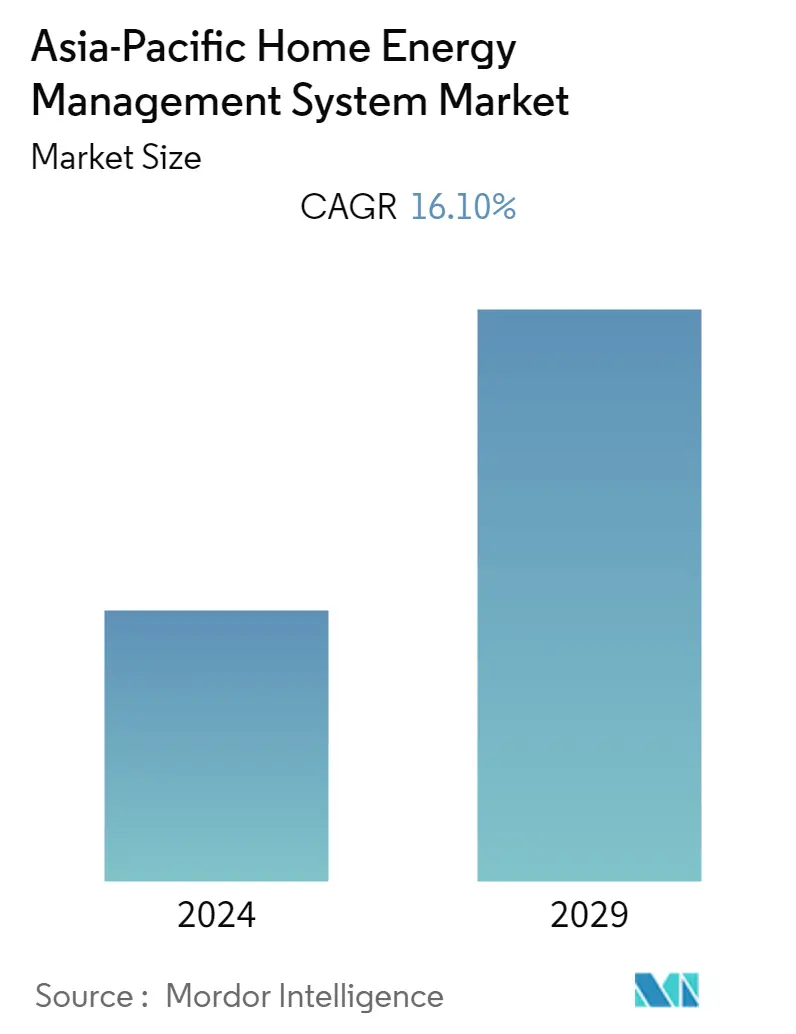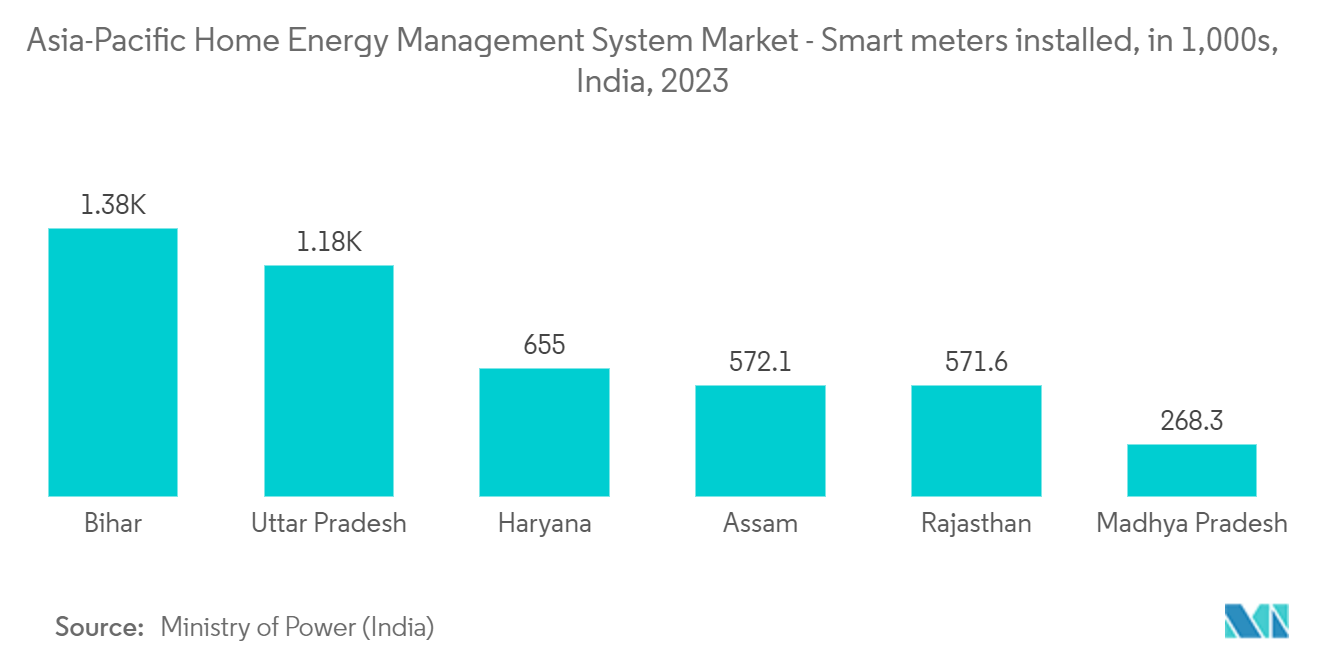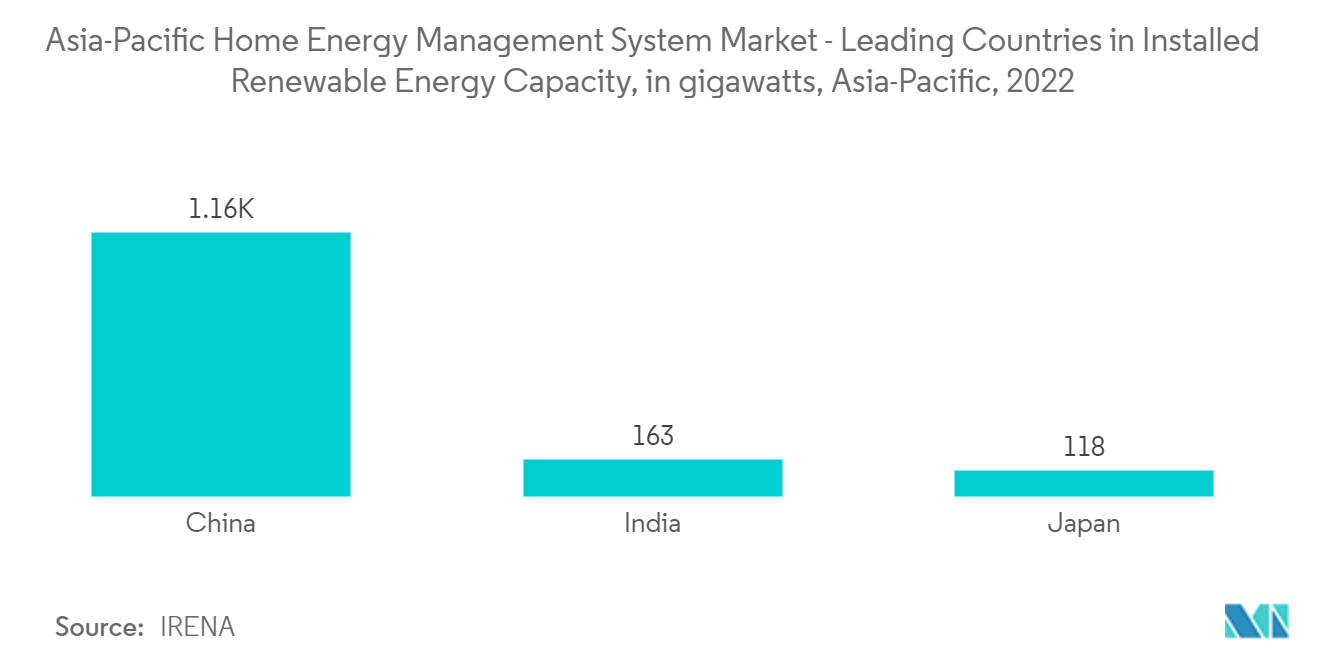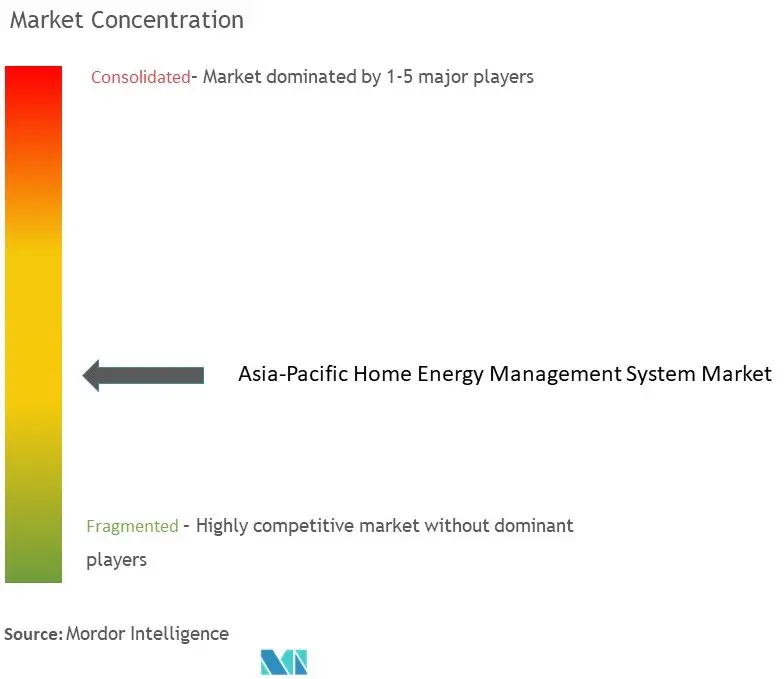Asia-Pacific Home Energy Management System Market Size

| Study Period | 2019 - 2029 |
| Base Year For Estimation | 2023 |
| Forecast Data Period | 2024 - 2029 |
| Historical Data Period | 2019 - 2022 |
| CAGR (2024 - 2029) | 16.10 % |
| Market Concentration | Medium |
Major Players
*Disclaimer: Major Players sorted in no particular order |
Asia-Pacific Home Energy Management System Market Analysis
The Asia-Pacific Home Energy Management System Market is expected to register a CAGR of 16.10% during the forecast period(2024-2029).
The Asia-Pacific home energy management system market is primarily growing due to rising awareness of energy management and rising investment in smart grids. According to IFSEC Global, China recently invested USD 75 billion in electricity grids.
- With rapid technological advancements, like network communication, bidirectional communication mediums, information infrastructures, energy conservation methodologies, and various techniques, home area networks (HANs) experienced a revolutionary change in numerous areas of power consumption domains, like energy saving at consumption premises and electricity usage patterns.
- For instance, in January 2022, Google launched Nest Hub's 2nd generation in the Indian market. The company claims to offer an improved audio experience with 50% more volume than the original hub and a third mic for better Google Assistant response. Featuring a 7-inch color display, this smart display doubles up as a digital photo frame.
- Furthermore, due to increasing concern about the efficient use of energy, there is an expanding focus on installing energy-saving devices in households. Energy management systems are cost-effective in all residential buildings, regardless of national energy prices, usage, or climatic factors. Thus, they are increasingly being adopted into homes.
- Various companies are innovating new solutions as part of their business expansion. For instance, in April 2022, Samsung Electronics partnered with international technology company ABB to expand Samsung SmartThings integration into more homes and buildings. Further, due to this collaboration, Samsung may strengthen its home IoT solution in the residential and commercial construction markets by combining smart home solutions with SmartThings for more advanced, economical, and energy-efficient solutions for monitoring and controlling homes and buildings.
- Furthermore, the hardware components of home energy management systems cost much more than the software and service components, which may further hamper the studied market's growth. In addition, for maintenance, the need for more skilled laborers across the region is expected to increase costs as most of them have to travel down to the service areas and resolve issues. However, the growing focus on remote maintenance may reduce the cost burden during the forecast.
- Since the novel COVID-19 was declared a pandemic, most firms and plants were closed or were under severe restrictions. On the other hand, energy consumption in homes increased drastically. However, power and energy consumption declined overall, mainly due to the break in manufacturing activity in China, India, and Japan. Nevertheless, relaxation of the restrictions was apparent in the months ahead. Given the government's initiatives to decrease energy consumption, the region is likely to create opportunities over the forecast period.
Asia-Pacific Home Energy Management System Market Trends
Hardware Component Holding Significant Market Share
- These systems allow the user to monitor energy usage and production and manually control or automate energy use within a household. With the help of these systems, a homeowner can remotely control various aspects of their home. It combines control, scheduling, and user information. Home energy management systems enable customers to modify their energy consumption patterns based on consumption details received through these systems. It includes smart meters, hub devices, smart plugs, lights, temperature sensors, smart devices, and others.
- Asia-Pacific is a diverse region with the potential to drive up demand for home energy management systems due to the significant production of smart meters in India and China. According to the Ministry of Power (India), as of April 2023, the Indian state of Bihar, with over 1.37 million smart meters, had the highest number of smart meters installed nationwide. Uttar Pradesh and Haryana followed.
- Furthermore, increasing the number of connected devices through the Internet of Things (IoT) may further create opportunities in the studied market. In April 2023, OnePlus announced its 5G router at the Cloud 11 event, with support for Wi-Fi 6 connectivity, 4G/5G SIM connectivity, a Home Hub with Matter protocol quality set, Home Mesh network support, and LED indicators.
- Also in September 2022, the EDMI launched the brand of the new solution, MIRA, for use in smart metering systems, heralding the bag of value and choice for the clients and customers of the Global Energy Solution Leader in retail, distribution, and metering services. Using industry-standard protocols like DLMS and IDIS and communication technologies like RF mesh, 4G, and NB-IoT, MIRA AMI facilitates the installation of various electrical devices. All upstream and downstream AMI systems can be easily and seamlessly integrated with MIRA AMI. This kind of innovation will accelerate market growth in the country.
- These improvements have mainly resulted from deploying smart meters, DES, and energy storage technologies but have also seen numerous pilot projects and developments into innovations like virtual power plants (VPPs), blockchain, and vehicle-to-grid (V2G) technologies. Additionally, the Japanese government's plans to spend JPY 20 trillion promoting investments in new power grid technology, energy-saving homes, and other technology to reduce the nation's carbon footprint may further drive the studied market growth.

China to Experience Significant Market Growth
- China dominates the Asia-Pacific home energy management market by country. The high penetration of solar PV and electric heating appliances helps grow the market. According to Saur Energy International, China installed over 87 GW of new solar capacity in 2022, a growth rate of over 60% compared to the previous year. Around 65%, or 55 GW, came from rooftop solar alone.
- In addition, according to IRENA, China was a significant player in renewable energy installations, with a capacity of around 1,161 gigawatts in 2022.
- A massive population in China is putting immense pressure on the government to increase the energy supply. According to preliminary data from the National Bureau of Statistics of China in January 2023, the Chinese population slightly decreased by 850,000 to around 1,411.75 million in 2022 and is expected to grow in the forecast period. Additionally, almost 6.5 million new residential properties were built in China recently, an increase from the previous years. Since the 1998 housing reform, the number of new homes has kept growing for over a decade.
- Furthermore, in August 2022, the Xiaomi Mijia Smart Socket 3 was released in China for 59 yuan. It helps to turn regular household devices, such as lamps and kettles, into smart gadgets. This also allows them to be controlled via an app or voice commands and linked with other items in the smart home network.
- In addition, in May 2022, BroadLink, China's significant smart home solution provider, launched the FastCon BLE smart home solution. BroadLink has applied FastCon BLE technology to a series of unique products, including the Starter Kit (which contains three smart bulbs, one scene switch, and one mini hub), as a pioneer in the smart home industry. Such developments in smart devices may further propel the studied market's growth in the region.
- Furthermore, increasing investment in grid digitization by implementing advanced communications technologies drives the growth of the residential energy management market. Over the next decade, China is expected to invest USD 6 trillion in infrastructure as part of its urbanization development program. China and the economy, which have signed a cooperation agreement with China on the Belt and Road Initiative (BRI), are rising as a share of the world economy.
- Moreover, governments are investing in various initiatives, such as renewable energy, adopting solutions that enhance the power grid's efficiency, and sanctioning the use of technologies that are not efficient. Further, under the theme of SCE, Smart Technology Empowering Economy, Enriching Life, 54 projects valued at CNY 1 billion were signed at the ongoing Smart China Expo (SCE) 2022 in Chongqing, southwest China. These projects, 80% of them in strategic emerging industries, aim at advancing Chongqing's smart city ambitions and growth as a smart manufacturing powerhouse.

Asia-Pacific Home Energy Management System Industry Overview
The Asia-Pacific home energy management system market is semi-consolidated, with various international players such as IBM, Honeywell, Schneider Electric, Rockwell Automation, and General Electric Company. The players in the market are launching products with technological developments and collaborating with different governments and firms to increase their market share. Some of the recent developments are:
In July 2023, Amazon launched a new affordable Echo smart speaker in India. The Echo Pop smart speaker comes with a unique semi-sphere design and support for Alexa. The smart speaker is now available on the Amazon website, Croma, Reliance Digital, Poorvika, and Amazon devices kiosks across India.
In November 2022, Schneider Electric, the international energy management and automation player, announced that its Wiser Gateway and Wiser Smart Plug are among the foremost products in the world to acquire Matter certification, furthering the company's complete home energy management offering.
Asia-Pacific Home Energy Management System Market Leaders
-
IBM Corporation
-
Panasonic Corporation
-
General Electric Company
-
Schneider Electric
-
Honeywell International Inc.
*Disclaimer: Major Players sorted in no particular order

Asia-Pacific Home Energy Management System Market News
- January 2023: Tapo, a TP-Link brand and international provider of smart home products, launched its first matter-compatible product, the Tapo P125M. Adopting the industry-unifying matter protocol, the smart plug is powered with convenient connectivity and delivers broad third-party integration.
- January 2023: Samsung announced a SmartThings Station, which uses multipurpose smart home devices that can double as a wireless charger for Galaxy smartphones and wearables. It is a 2-in-1 device with a hub for smart home products, including Matter-enabled devices, and it also has a fast wireless charging pad.
Asia-Pacific Home Energy Management System Market Report - Table of Contents
1. INTRODUCTION
- 1.1 Study Assumptions and Market Definition
- 1.2 Scope of the Study
2. RESEARCH METHODOLOGY
3. EXECUTIVE SUMMARY
4. MARKET INSIGHTS
- 4.1 Market Overview
-
4.2 Industry Attractiveness - Porter's Five Forces Analysis
- 4.2.1 Bargaining Power of Suppliers
- 4.2.2 Bargaining Power of Buyers
- 4.2.3 Threat of New Entrants
- 4.2.4 Threat of Substitutes
- 4.2.5 Intensity of Competitive Rivalry
- 4.3 Industry Value Chain Analysis
- 4.4 Assessment of Impact of COVID-19 on the Market
5. MARKET DYNAMICS
-
5.1 Market Drivers
- 5.1.1 Increasing Usage Of Smart Grids and Smart Meters
- 5.1.2 Increasing Government Initiatives Towards Energy Efficiency
-
5.2 Market Challenges
- 5.2.1 High Initial Installation Costs Coupled with Maintenance Costs
6. MARKET SEGMENTATION
-
6.1 By Component
- 6.1.1 Hardware
- 6.1.2 Software
- 6.1.3 Services
-
6.2 By Product
- 6.2.1 Lighting Controls
- 6.2.2 Self-Monitoring Systems and Services
- 6.2.3 Programmable Communicating Thermostats
- 6.2.4 Advanced Central Controllers
- 6.2.5 Intelligent HVAC Controller
-
6.3 By Technology
- 6.3.1 ZigBee
- 6.3.2 Wi-Fi
- 6.3.3 Internet
- 6.3.4 Z-Wave
- 6.3.5 Other Technologies
-
6.4 By Country
- 6.4.1 China
- 6.4.2 India
- 6.4.3 Japan
- 6.4.4 South Korea
- 6.4.5 Rest of the Asia-Pacific
7. COMPETITIVE LANDSCAPE
-
7.1 Company Profiles
- 7.1.1 IBM Corporation
- 7.1.2 Panasonic Corporation
- 7.1.3 General Electric Company
- 7.1.4 Schneider Electric
- 7.1.5 Honeywell International Inc.
- 7.1.6 Eaton Corporation
- 7.1.7 Enel X
- 7.1.8 SAP SE
- 7.1.9 Google LLC
- 7.1.10 Comcast Corporation
- 7.1.11 Generac Holdings, Inc.
- 7.1.12 Vivint Smart Home, Inc.
- *List Not Exhaustive
8. INVESTMENT ANALYSIS
9. FUTURE OF THE MARKET
** Subject To AvailablityAsia-Pacific Home Energy Management System Industry Segmentation
A home energy management system is a technology-based platform comprising hardware and software that authorizes the user to monitor power usage and production and manually control and automate energy use within a household. The HEMS performs at the intersection of three different sectors within a home: home appliances, metering, and the communication network.
The Asia-Pacific home energy management system market is segmented by component (hardware, software, and services), product (lighting controls, self-monitoring systems, and services, programmable communicating thermostats, advanced central controllers, intelligent HVAC controllers), technology (ZigBee, Wi-Fi, Internet, Z-Wave, and other technologies), and country (China, India, Japan, South Korea, and the Rest of Asia-Pacific). The market sizes and forecasts are provided in terms of value in USD for all the segments.
| By Component | Hardware |
| Software | |
| Services | |
| By Product | Lighting Controls |
| Self-Monitoring Systems and Services | |
| Programmable Communicating Thermostats | |
| Advanced Central Controllers | |
| Intelligent HVAC Controller | |
| By Technology | ZigBee |
| Wi-Fi | |
| Internet | |
| Z-Wave | |
| Other Technologies | |
| By Country | China |
| India | |
| Japan | |
| South Korea | |
| Rest of the Asia-Pacific |
Asia-Pacific Home Energy Management System Market Research Faqs
What is the current Asia-Pacific Home Energy Management System Market size?
The Asia-Pacific Home Energy Management System Market is projected to register a CAGR of 16.10% during the forecast period (2024-2029)
Who are the key players in Asia-Pacific Home Energy Management System Market?
IBM Corporation , Panasonic Corporation, General Electric Company, Schneider Electric and Honeywell International Inc. are the major companies operating in the Asia-Pacific Home Energy Management System Market.
What years does this Asia-Pacific Home Energy Management System Market cover?
The report covers the Asia-Pacific Home Energy Management System Market historical market size for years: 2019, 2020, 2021, 2022 and 2023. The report also forecasts the Asia-Pacific Home Energy Management System Market size for years: 2024, 2025, 2026, 2027, 2028 and 2029.
Asia-Pacific Home Energy Management System Industry Report
Statistics for the 2024 Asia-Pacific Home Energy Management System market share, size and revenue growth rate, created by Mordor Intelligence™ Industry Reports. Asia-Pacific Home Energy Management System analysis includes a market forecast outlook to for 2024 to 2029 and historical overview. Get a sample of this industry analysis as a free report PDF download.



